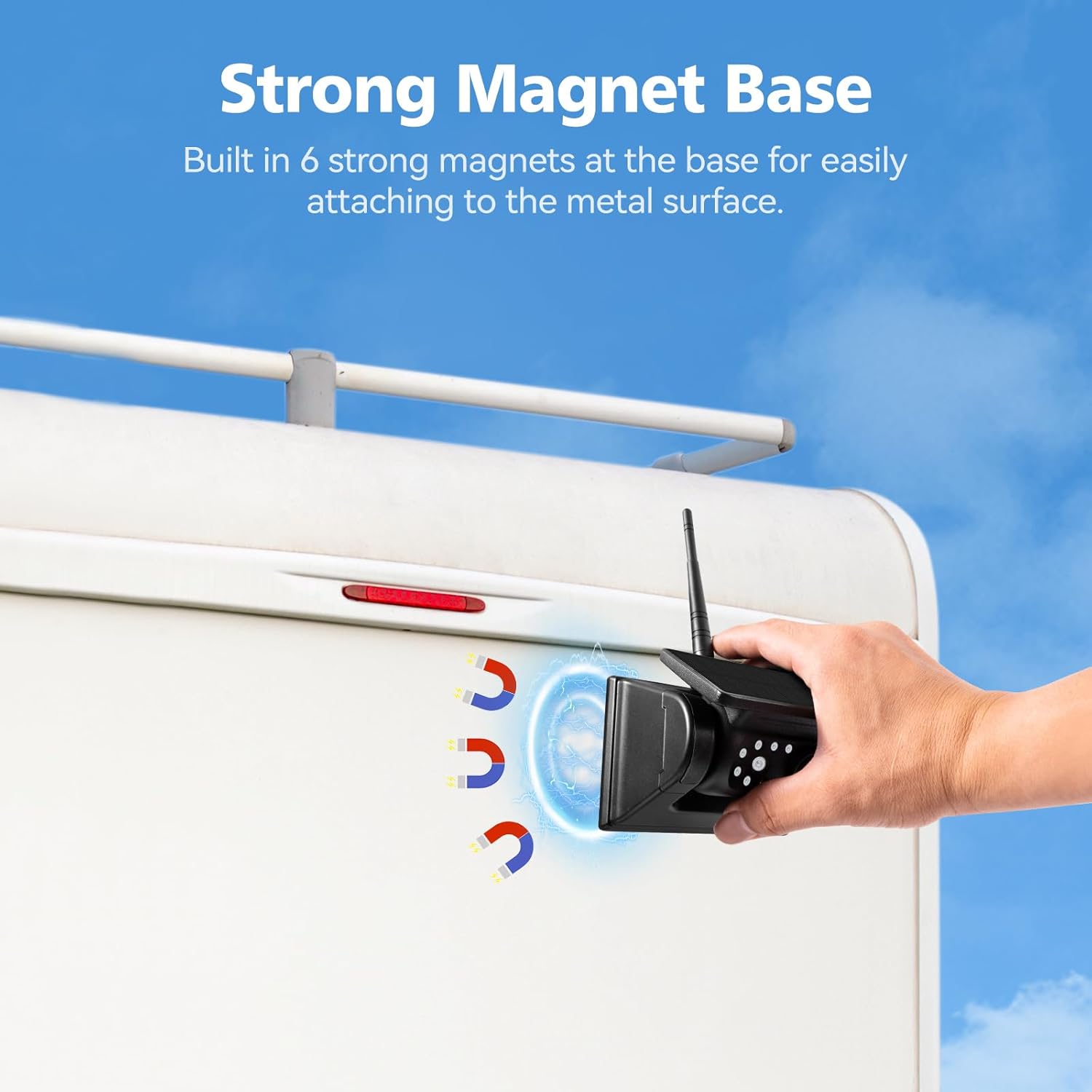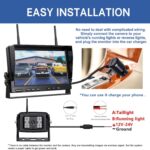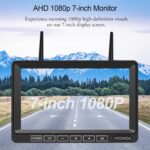? Want a backup camera system that you can mount in a minute, move between vehicles, and trust in rain or at night?
Quick first impression
You’ll notice right away that the 1080P 7″ Magnetic Wireless RV Backup Camera System, 2 Rear Cameras + 2 Side Cameras for Reversing/Monitoring Trailer Camper, 1080P DVR Monitor, 4x9600mAh Waterproof IR Night Vision RV Cameras is built around convenience and all-weather reliability. The kit feels like it’s targeted at RV and trailer owners who want serious visibility without permanent wiring or complicated installs.
You’ll appreciate the magnetic mounts and the rechargeable batteries because they remove the usual headache of running cables through tailgates or drilling into bumpers. The 7″ 1080p monitor looks modern and the promise of always-on DVR recording makes this feel like a full surveillance solution rather than a simple reverse camera.
What’s in the box
You’ll find four magnetic cameras, a 7″ DVR monitor, charging cables, power adapters, and a basic hardware kit for mounting. Everything necessary for quick setup is included so you won’t need to buy extra parts just to get it working.
The package typically includes Type-C cables for charging the cameras and both a 12V DC vehicle charger plus a USB power cable for the monitor. That means you can power the screen from a cigarette socket or a USB power bank if needed.
Included components
You’ll get the following components in the standard kit: four cameras, a 7″ 1080p monitor with DVR, four Type-C charging cables/adapters, a 12V vehicle charger for the monitor, a USB power cable, and basic mounting hardware. The inclusion of multiple charging adapters makes topping up the included 9600mAh batteries quick and convenient.
You should also find instructions and warranty/contact details so you can request the tutorial video if you want a guided setup. If any component is missing or damaged, contacting customer service will usually get you a replacement or a how-to video.
Key specifications
You’ll want a clear snapshot of the core specs before committing, and the table below makes that straightforward. These are the primary numbers and capabilities to help you evaluate fit for your vehicle or trailer.
| Feature | Specification |
|---|---|
| Cameras | 4 (2 Rear + 2 Side magnetic) |
| Camera resolution | 1080P (Full HD) |
| Monitor | 7″ 1080P DVR Monitor, anti-glare |
| Camera battery | 4 x 9600mAh rechargeable |
| Charging | Type-C cables and premium adapters included |
| Mounting | Magnetic base (tool-free), quick-release |
| Wireless frequency | 2.4GHz with dual antennas |
| Range | Up to 330 ft (open area) |
| Waterproof rating | IP69K (high-pressure wash protection) |
| Night vision | IR automatic night mode (black-and-white) |
| Recording | Loop recording, supports SD up to 128GB |
| Extra features | Parking guide lines, flip/mirror image |
These specs show that the system is designed to be a robust, portable, and high-resolution solution suitable for larger vehicles that need multi-angle monitoring. The IP69K rating and large battery capacity are notable for people who travel in remote or rough conditions.
Camera hardware details
You’ll find that each camera has a compact form factor with a built-in magnet and a sealed housing for weather protection. The cameras are optimized for vehicle use with an IR lens for night vision and ruggedized enclosures.
One special hardware feature is the magnetic side-view camera’s 180° rotation capability; to adjust it you simply loosen the screws under the rubber plate on the top and then re-tighten after positioning. If you prefer a visual guide, the seventh image on the product page links to a tutorial video, or you can contact customer service to request that video.
Monitor and DVR features
You’ll use the 7″ monitor for live viewing, multi-camera split screens, and instant playback of DVR footage. It supports full-screen, split-view, and quad-view modes so you can choose the layout that matches your driving or parking needs.
The DVR supports loop recording and accepts an SD card up to 128GB so your system records automatically and overwrites older files as storage fills. You can replay footage instantly on the monitor which is useful if you need to verify an incident right away.
Installation and setup
You’ll be surprised how fast installation can be — many users report attaching the magnetic cameras and powering the monitor in minutes. The tool-free magnetic design is the central feature that enables rapid setup and fast relocation.
Still, you’ll want to position the cameras thoughtfully and fully charge the batteries before long trips to get the best performance. Below are step-by-step tips and best practices to make setup painless and reliable.
60-second tool-free installation
You’ll attach each camera to any ferrous metal surface using the high-strength magnetic base without drilling or wiring. With integrated batteries the cameras are autonomous, and because each camera charges with the included Type-C cable you can get them charged quickly and be on the road fast.
The magnet design allows you to move cameras between vehicles or different positions on the same vehicle quickly — handy for rental trailers or when you switch between towing setups. Just make sure the metal surface is clean and flat for the strongest magnetic hold.
Adjusting the magnetic side-view camera angle
You’ll be able to rotate the magnetic side camera up to 180° to get the perfect field of view for your trailer or RV. To change the angle, lift the rubber plate on top of the camera, loosen the small screws beneath it, rotate the camera to the desired position, then re-tighten the screws and reseal the rubber plate.
If you’re unsure how to do this, find the seventh image on the product page to access a how-to video that shows the exact steps. If the visual aid isn’t accessible, customer service can send the tutorial or walk you through the adjustment.
Mounting tips and placement suggestions
You’ll want to plan camera placement before sticking the magnets on to avoid re-positioning during a trip. For rear cameras mount them centrally on the bumper or tailgate for balanced perspective; for side cameras choose a location that maximizes a view of the trailer sides and blind spots.
You should also consider using a secondary mechanical backup (like a strap or small chain) if you frequently drive over extremely rough roads or at times when high winds could be an issue. The magnets are strong, but an added tether gives you extra peace of mind.
Performance in real conditions
You’ll appreciate the clarity in daytime and the usable contrast at night thanks to the 1080p cameras and smart IR. The monitor’s anti-glare screen keeps images visible even in bright sun, which is important when you’re reversing or changing lanes.
Real-world performance also depends on how you mount the cameras and whether you keep the lenses clean, but the core tech—solid signal handling and large batteries—means the system is made for practical, everyday use.
Video quality and night vision
You’ll notice sharp 1080p images during the day with good color and detail, making it easy to judge distance and identify objects behind you. At night the IR night vision switches to black-and-white and provides clear outlines; it’s not Hollywood-level clarity in absolute darkness, but it’s excellent for hazard detection and lane guidance.
If you need near-color detail in low light, supplemental lighting on your vehicle helps, but for most reversing and monitoring tasks this IR implementation is reliable. The DVR captures the same quality so recorded evidence retains the detail seen live on the monitor.
Wireless stability and range
You’ll get a stable connection thanks to the 2.4GHz wireless transmission and dual antennas, which handle vehicle movement and highway speeds surprisingly well. In open areas the signal can reach up to 330 feet, giving you flexibility when towing long trailers or using the system on larger rigs.
Obstacles like metal cargo or heavy trailer sides can reduce range, so you should test camera placement before hitting the road. The system is engineered to automatically maintain signal pairing so you won’t need to fiddle with reconnections often.
Battery life and charging
You’ll rely on the 9600mAh battery per camera for long runtime between charges, and the included Type-C cables and premium adapters make recharging relatively quick. Battery life depends on camera activity and temperature, but the large capacity is a major advantage for day-long trips and intermittent monitoring.
You should fully charge the cameras before long trips and consider bringing a power bank or vehicle charger for top-ups during extended outings. The magnets make it easy to bring cameras indoors to charge before your next departure.
Weather resistance and durability
You’ll find the cameras built to withstand tough conditions with an IP69K rating, which covers high-pressure washing and protection from water and dust ingress. That rating makes them a solid pick for all-season travel and heavy-duty use on trailers or work trucks.
Despite robust sealing, you should still wipe lenses and inspect mount points after off-road or saltwater exposures to reduce corrosion risk. The rugged housing and magnetic base provide a durable, user-friendly combination for rough environments.
Usability and interface
You’ll find the monitor straightforward to use with tactile buttons and a clear on-screen menu for mode switching and settings. The interface focuses on essential controls like view mode, playback, recording options, and camera selection so you can keep your eyes on the road.
The anti-glare screen is a thoughtful touch for daytime driving, and the quad/full/split view switching is intuitive for different driving or parking scenarios.
Monitor controls and views
You’ll be able to tap between full-screen, split-view, and quad-view layouts quickly to match your driving needs. The system also allows mirroring or flipping images so you can correct views when mounting cameras upside down or angled.
Parking guidelines are available and can be toggled on or off, which helps when you want factory-style reversing assistance or a cleaner, unobstructed view. The physical controls are responsive and the menu is clear enough that you’ll become comfortable within a few uses.
Recording, playback, and storage
You’ll get continuous loop recording, which records until the SD card fills and then overwrites the oldest files so you don’t have to manage storage constantly. The monitor supports instant playback so you can review incidents without removing the SD card from the DVR.
The system supports SD cards up to 128GB, which gives you a healthy buffer of storage before overwrites begin. If you need continuous archival you’ll want to regularly transfer important clips to a computer or external drive.
Pros and Cons
You’ll get a balanced picture of where this system excels and what could be better. Below are the clear advantages and the trade-offs to consider before buying.
Pros:
- You’ll love the tool-free magnetic installation and quick relocation between vehicles.
- You’ll benefit from long-lasting 9600mAh batteries and multiple charging adapters.
- You’ll have 1080p resolution on both cameras and monitor for clear daytime video.
- You’ll enjoy IP69K weather resistance and dependable IR night vision.
- You’ll appreciate the DVR loop recording and instant playback on the monitor.
- You’ll get strong 2.4GHz wireless connectivity with a solid open-range performance.
Cons:
- You may find the cameras less sharp in very low light compared to daytime footage; IR is strong but naturally monochrome at night.
- You’ll need to remember to charge the cameras for long trips unless you have ready access to charging points.
- You might experience reduced wireless range around large metal obstructions or internal trailer cargo which can interrupt a line-of-sight signal.
- You’ll need to buy a larger SD card separately if you want maximum recording time beyond the included default.
Troubleshooting common issues
You’ll want to know how to handle issues quickly so the system remains a reliable asset when traveling. The tips below cover the most common problems owners report and how to resolve them.
Start with basic checks like power status, cable connections, and camera positioning before assuming hardware failure. More often than not, simple adjustments fix the problem.
Signal dropouts
You’ll often resolve dropout issues by repositioning a camera’s magnet to reduce signal obstruction from metal or cargo. Also try moving the monitor or adjusting the antenna orientation to improve line of sight between camera and receiver.
If you still see intermittent signal, test each camera independently with the monitor nearby to isolate the problem. Sometimes interference on the 2.4GHz band (from Wi‑Fi or other devices) can be mitigated by changing monitor placement or testing at different locations.
Battery not charging / battery issues
You’ll troubleshoot charging problems by checking the Type-C cable and adapter first, and by confirming the camera contacts and port are free of corrosion or debris. Swap cables and adapters from the box to verify whether the issue is cable-related rather than battery-related.
If charging still fails, contact customer service because the 9600mAh cells should work as advertised and replacements are often covered under warranty. Also make sure you keep batteries out of extreme cold during charging as temperature can affect charging speed and capacity.
Night vision problems
You’ll notice reduced night view if the IR LEDs are blocked, the lens is dirty, or the camera’s angle is misaligned. Clean the lens with a microfiber cloth and verify the camera is not facing an external IR source that could wash out contrast.
If the black-and-white image is too dim, add auxiliary reverse lights on your vehicle which the camera will pick up and improve detail without losing the benefit of IR for dark angles.
Comparison with alternatives
You’ll want to know how this kit stacks up against hardwired or single-camera systems, especially if you’re weighing portability against permanence. Below are direct comparisons to help you decide.
Compared to hardwired systems
You’ll find hardwired systems tend to offer permanently powered cameras and fewer concerns about battery charging; however, they require drilling, running cables, or professional installation. The magnetic wireless approach beats hardwiring when flexibility and quick setup across vehicles are priorities.
If you need a permanent, tamper-proof installation with constant power and no battery maintenance, hardwired is still a solid choice. But if you manage multiple trailers or want the ability to remove cameras when parked, this wireless magnetic kit gives you versatility that hardwired systems can’t.
Compared to single-camera wireless kits
You’ll notice single-camera kits are cheaper and easier to install but don’t give the multi-angle coverage you’ll get from a 4-camera set. This kit is a better option if you need 360° visibility, especially for larger rigs and trailers where blind spots are a real safety issue.
If you only need a rear view for a small vehicle, a single-camera system might be sufficient and more budget-friendly. For RVs, trailers, and trucks where side monitoring matters for lane changes and towing, the multi-camera setup is worth the added expense.
Who should buy this system
You’ll find this system ideal if you own an RV, trailer, or truck and you move cameras between vehicles or frequently change towing setups. It’s also a great pick if you want a non-permanent, high-resolution solution that records continuously for security or insurance purposes.
If you rarely park trailers or need a permanent OEM-like install, consider whether battery management is a trade-off you’re willing to accept. For most RVers and tow vehicle owners who value portability and quick installation, this strikes a compelling balance.
Final verdict
You’ll get outstanding value if you prioritize ease of installation, portability, and all-weather performance in a backup camera system. The 1080P 7″ Magnetic Wireless RV Backup Camera System, 2 Rear Cameras + 2 Side Cameras for Reversing/Monitoring Trailer Camper, 1080P DVR Monitor, 4x9600mAh Waterproof IR Night Vision RV Cameras offers a rare mix of rugged hardware, long battery life, and reliable DVR recording.
You’ll still need to manage charging and test placement for optimal wireless performance, but once dialed in this system becomes a dependable partner for safer reversing, lane changes, and trailer management.
FAQs
You’ll find answers to commonly asked questions here to clear up any last-minute concerns.
Q: How long do the camera batteries last on a single charge?
You’ll typically see variable run times depending on usage and temperature, but the 9600mAh cells are designed to provide many hours of operation between charges. If you plan all-day monitoring, carry a power bank or top up between stops.
Q: Can you mount the cameras on non-metal surfaces?
You’ll need ferrous metal for the magnet to attach securely; on non-metal surfaces you can use a metal plate or an additional mechanical mount to provide a magnetic surface. Using a strap or extra bracket is another common solution for plastics or composite bumpers.
Q: Does the DVR start recording automatically?
You’ll have automatic loop recording once the monitor and cameras are powered and an SD card is inserted. The system continuously records and overwrites older files so you don’t run out of space.
Q: Can the monitor be powered by a USB power bank?
You’ll be able to power the monitor using the included USB cable, so a USB power bank is an option if you prefer mobile power. For long-term use you’ll typically want the 12V vehicle power source for continuous operation.
Q: How do I get the tutorial video for adjusting the camera angle?
You’ll find the tutorial by clicking the seventh image on the product page to watch the step-by-step video, or you can contact customer service to request the tutorial if the link isn’t accessible. They’ll guide you through loosening the screws under the rubber plate and rotating the camera to the correct angle.
Q: Is the wireless connection reliable at highway speeds?
You’ll usually maintain a stable connection at reasonable highway speeds thanks to the dual-antenna 2.4GHz design, but metal loads or extreme trailer arrangements can affect the signal. Test your setup before long trips to confirm connectivity under your specific towing conditions.
Q: What SD card size should I buy for long recording times?
You’ll get the most practical balance with 64GB to 128GB depending on how long you want to archive footage before transfer. A 128GB card delivers the longest onboard retention before overwrites occur.
Q: Are replacement batteries available?
You’ll likely be able to buy replacement batteries or contact customer support for options, as the system’s integrated battery is a key feature. If your batteries start to show degraded capacity after extended use, check warranty coverage and replacement policies.
Q: Can the cameras withstand saltwater exposure?
You’ll benefit from the IP69K rating for protection against moisture, but prolonged saltwater exposure can still cause corrosion over time. Rinse with fresh water and dry thoroughly after saltwater exposure to extend life.
Q: Is professional installation recommended?
You’ll rarely need professional installation for this kit because of its tool-free magnetic design, but if you prefer a permanent, hardwired solution you might consult a professional. For the standard usage scenario of quick mounting and portability, DIY installation is simple.
If you want, I can create a quick setup checklist or tailored mounting plan for your specific vehicle and trailer so you can be ready for your next trip.
Disclosure: As an Amazon Associate, I earn from qualifying purchases.













